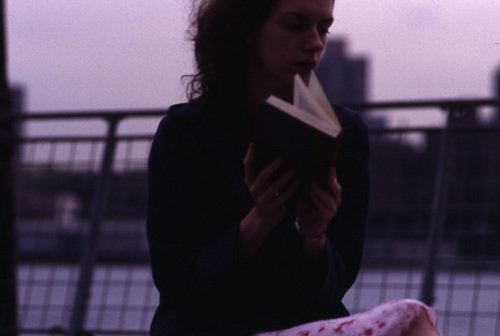Noritoshi Hirakawa
dal 2/11/2006 al 25/1/2007
Segnalato da
2/11/2006
Noritoshi Hirakawa
Baukunst Galerie, Koln
Nothing incomprehensible

Nothing incomprehensible
The Baukunst Galerie opens on Friday, the 3rd of November 2006 from 7 p.m. to 10 p.m. a second exhibition of the works of Noritoshi Hirakawa. The show entitled "Nothing incomprehensible" includes artist-films, slide-projections and photographs, which provide an insight into the broad spectrum of the opus by the artist, who lives and works in New York. The exhibition is the sequel to the performance "Four two One" of Hirakawa, which was primarily staged at the 30th and 31st of August at the Baukunst Galerie.
The works of Noritoshi Hirakawa, born in 1960 in Fukuoka (J), were already presented world wide in several solo- and group-exhibitions - among others at the Venice Biennale, the Kunsthalle Zurich, the P.S.1 in New York, the Museo Nacional De Bellas Artes in Buenos Aires, the Museum of Fine Arts in Houston, the Shoto Museum in Tokio, the SESC in Sao Paulo (BRA), the Yokohama Museum of Art and recently at the ZKM in Karlsruhe. The artist makes photographs, videos and installations and directs dances and performances. Using these media he explores suppressed elements of social structure. Noritoshi Hirakawa’s works are always a result of personal, psychological and social studies. Restrictive moral standards and taboos are revealed and subverted in order to bring them to mind of the spectator. They can only be completely recognised against the background of the moral restrictions in the Japanese society.
In the artist-film "Four two One", which was created in the context of the performance, Hirakawa deals with the social taboo of the subconscious desires between father and daughter. Beneath the surface of daily communication the story steps into a subconscious level as a dialogue of existential impact. The inner conflict of the leading actress is dramatically staged by the appearance of her "spirit" embodied by a masked and naked female dancer. Against the background of the musical improvisations the feelings of the father and the daughter assume a definite, intense form, when they are bonded to each other by a tragic, unconscious destiny.
In the installation "A Temptation to be a Man" (1997), which was recently exhibited at the ZKM in Karlsruhe, you can see the slide-projection of a young woman, laying diagonal on a bed, offensively displaying her naked body. The bright spot pointing on the projection obstructs the view at her face. When the spectator is lead into the temptation to break the light beam, the self-confident and satisfied smile of the model is revealed. The cultural distrust against the dominance of the ‘male view’ is contrasted with the power of female eroticism. At the same time the interaction between the spectator and the unveiled model enables him to experience the censure of the sexual desire in his own mind.
In the three parted slide projection "A fruitful wavers" (2002) - similar to several of his photographs - Hirakawa broaches the issue of intimate actions, which are tolerated by society just in private but not in public space. In three short-stories the spectator is confronted with assumed innocent situations, which suddenly culminate and partake in the inner drive of a foreign person, who practises against all obligations an intimate action in the midst of public space. The slide-projections confront us with those daily moments of our thoughts and actions, which embody a social taboo but being familiar to us - whether we do not want to share them with other people.
In the work "The Light of Shueng Wan" (2006) a young woman passes a musician playing the violin on her way back home and follows her inner impulse when she starts to dance. This spontaneous impulsivity attracts the attention of a passing man, who begins to accompany both by drumbeats on an empty water bottle.
Dance is also a configuring element of the artist-film "Le va et vient" (The running around) of 1999. By combining the three Caribbean dances Mazurka, Zouk and Soca, originated in the African-Indian population of the islands, Hirakawa expounds the problems of racial separation at the island of Martinique: Although the coloured population represents 90 % of the total population, the minority group of the white settlers dominate economy, politics and cultural life. This becomes apparent in the first and last film-scenes, in which Hirakawa provides an insight into an annual, social event, till this day only white people are allowed to take part. While this society exclusively dances waltz, the Caribbean dances, which are practised by the majority of the population of Martinique, are performed by three coloured people on a gas station along a road.
Noritoshi Hirakawa claims by the title "Nothing incomprehensible", that everything is comprehensible. All human phenomena - either impulsive or intimate actions, suppressed or eruptive drives or emotional needs - concern and affect everyone of us. Nevertheless people often try to separate from each other or from certain sections of thoughts, feelings and actions by social restrictions. On the long run these homogenising dictates of culture lead to a denial of the own complexity of the personal desires and psychological requirements. Noritoshi Hirakawa’s works seduce us by their story line or their aesthetics and thusly allow us to approach those suppressed subjects and find inner parallels. It is that emotional approach, which opens the door to the realisation: "Nothing is incomprehensible"...
Image: Noritoshi Hirakawa, A fruitful wavers, 2002, slideprojection 3 parts a' 80 slides, edition of 3, detail: Calla
Baukunst Galerie
Theodor-Heuss-Ring 7 D - 50668 Cologne



